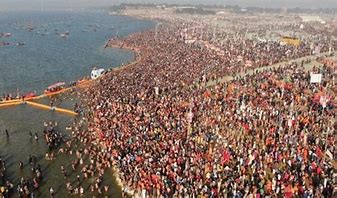Ancient Kings gathered at Kumbh in Prayagraj to donate wealth to people, Brahmins and seers
By BK Singh
The Kumbh Mela, one of the largest and most significant religious gatherings globally, is deeply rooted in Hindu traditions. Prayagraj, historically known as Prayag, is among its renowned locations, where the Ganges, Yamuna, and Sarasvati rivers converge. The tradition of Indian kings attending the Kumbh Mela stretches back centuries, reflecting the intersection of political authority and spiritual devotion in India’s rich history.
Historical Background
The origins of the Kumbh Mela are ancient, mentioned in sacred texts like the Vedas, Puranas, and various historical accounts. The festival’s mythology is tied to the tale of the Samudra Manthan (churning of the ocean), where a pot (kumbh) containing the nectar of immortality (Amrit) surfaced. This cosmic event is believed to have occurred at the locations now associated with the Kumbh Mela, including Prayagraj.
Royal Participation
Historically, the Kumbh Mela drew vast numbers of devotees kings, and rulers from across the Indian subcontinent. These monarchs undertook arduous journeys to attend the sacred event, driven by motivations such as spiritual merit, demonstrating their power, and asserting their moral authority through acts of charity and devotion.
Spiritual Pursuits
For rulers, participating in the Kumbh Mela was a way to fulfill their dharma (moral duty) and reinforce their legitimacy as just and pious leaders. The pilgrimage was also seen as a means of attaining salvation and purifying oneself of sins.
Power and Prestige
The presence of kings among the masses underscored their status and influence. Engaging in rituals alongside their subjects allowed monarchs to showcase their commitment to shared beliefs and traditions.
Acts of Charity and Benevolence
A hallmark of the Kumbh Mela was the extensive charity conducted by kings, who distributed wealth and resources to pilgrims and the underprivileged. This tradition served both spiritual and social purposes.
The Practice of Daan (Charity)
In Hindu culture, daan is a virtuous act that yields spiritual benefits. Kings organized large-scale donations, providing essentials like food, clothing, and money to attendees, thereby earning goodwill and blessings.
Establishing Institutions
Many rulers founded religious institutions such as guesthouses (dharamshalas), hospitals, and schools during the Kumbh Mela. These establishments offered immediate relief to attendees while contributing to the long-term welfare of society.
Community Feasting
Rulers often organized community kitchens (langars) that served free meals to people regardless of caste or creed. This practice fostered social unity, emphasized equality, and highlighted the king’s role as a benevolent caretaker of his subjects.
Support for Brahmins and Religious Leaders
Kings frequently granted wealth and land to Brahmins and religious leaders during the Kumbh Mela. These contributions supported the custodians of Hindu rituals and upheld the principles of dharma.
Conclusion
The Kumbh Mela at Prayagraj has long been a symbol of spirituality, communal harmony, and royal leadership. The participation of ancient kings and their charitable efforts at this sacred event demonstrates the integration of governance and spirituality in Indian culintore.
Today, the Kumbh Mela continues to embody this legacy, serving as a hub of pilgrimage and philanthropy. The enduring tradition reflects the core values of charity, community, and faith that have shaped Indian society, preserving the ethos of ancient times where rulers displayed their dedication to their people and their beliefs through acts of kindness and generosity.

